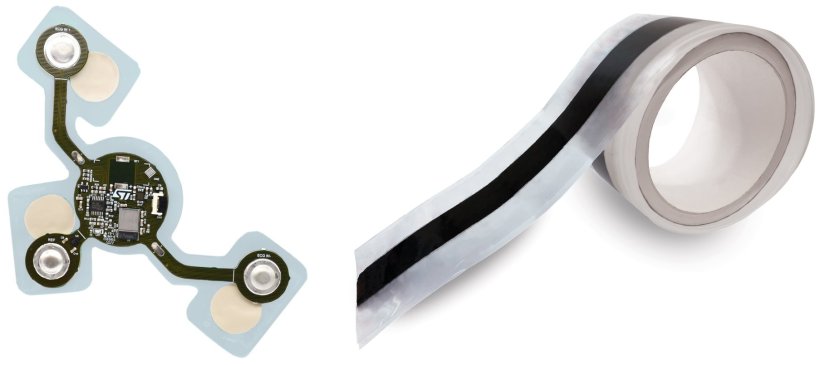
© Liveo
Article • E-skin patches
How “intelligent” skin could highlight cardiac conditions
Two companies are combining their unique expertise to develop intelligent e-skin patches to “self-sense” cardiac events in patients. The flexible patch platform will deliver a comprehensive understanding of both electrical and mechanical heart activities and has the potential to enable cardiologists to better monitor their patients.
Report: Mark Nicholls
The initiative, which sees STMicroelectronics and DuPont Liveo Healthcare working to develop the wearable platform, was outlined during a presentation by Oriana Di Marco from STMicroelectronics and DuPont’s Jennifer Gemo at Medica in Dusseldorf in November.

Speaking to Healthcare in Europe after the conference, Di Marco, who heads EMEA Strategic Business Development for Health &Well-being at STMicroelectronics, said: ‘The companies’ respective contributions to this development is our long-term vision for an intelligent electronic skin patch that can self-sense a cardiac event and act immediately at the point of need.’
For the e-skin project, STMicroelectronics provide a smart, flexible electronic board with innovative sensing, low power management, processing, and in-sensor and microcontroller AI capability embedded in a single module. This technology pairs with the DuPont Liveo silicone technology with electrically conductive properties.
Durable, but gentle

Gemo, who is Global Strategic Marketing Leader with DuPont Liveo Healthcare, explained how medical professionals can use Liveo Soft Skin Conductive Tape as a skin electrode for biosignal monitoring. She emphasised that good skin conformability, no drying over time, and repositionability with gentle adhesion and atraumatic removal are vital. ‘The conductive tape can be used in single electrodes for short-term monitoring, as well as in medical wearable patches for long-term monitoring lasting seven or more days,’ she continued.
DuPont – which carried out the full design, processing, and assembling of the patch prototype solution – also provides a toolbox for wearable medical devices that includes biomedical grade elastomer for hardware encapsulation and soft skin adhesive for skin gentleness, repositionability, and long wear time of the patch onto the body.
Synchronized and contextualized measurements
Di Marco outlined how the flexible patch platform prototype supports heart monitoring. As electrocardiography (ECG) and seismocardiography (SCG) signals are detected in the same sensor, they are fully synchronized as they occur. ‘Moreover, by using the artificial intelligence capabilities embedded in the sensor and in the microcontroller, it’s possible to contextualize the measurement within the wearer's daily activities as well as supporting the derivation of other vital signs like non-invasive blood pressure, in addition to respiration rate and heart beats,’ said Di Marco.
Clinicians benefit from a better understanding of the heart rhythm and main vital signs during a patient’s visit and once they have left the doctor’s practice. ‘The patch’s intelligence lets it detect changes in normal patterns and alert the patient, who can share the data with the physician,’ she added.
Catering to cardiologists’ requirements
Cardiologists [...] are clamouring for small, flexible, and waterproof patches that deliver improved comfort, longer wear, and higher signal quality over time
Jennifer Gemo
Patient benefits are related to the characteristics of the wearability of the patch. The patch can be worn longer without irritating the skin and it is flexible, lightweight, and can be repositioned easily. In terms of how this is advancing the field and patient care, Gemo said: ‘The cardiac market is one of the most advanced in technological adoption, with cardiologists demanding longer wearability, better data, and superior design. They are clamouring for small, flexible, and waterproof patches that deliver improved comfort, longer wear, and higher signal quality over time.’
Such requirements are driving the trend for continuous and remote cardiac monitoring outside of the hospital and in patient’s homes, where patient comfort leads to improved compliance.
The two companies have provided a toolbox of technologies to address these needs and delivered a prototype that improves signal quality and patient comfort over time.
Next step
The patch is also suited to applications beyond cardiac monitoring. It can be positioned in various places of the body and use different algorithms to detect other biological functionalities.
For DuPont Liveo, the next step is to build prototype patches for further testing and to provide reference designs and components to build similar patches to monitor other functions. While acknowledging that vital-sign monitoring is a high-growth market, Gemo said its key needs are improved signal quality and patient comfort.
STMicroelectronics and DuPont have portfolios suited for wearables and electronic skin patch applications. DuPont Liveo Healthcare enables next-generation wearables through its toolbox of technologies, including medical-grade elastomers, adhesives, resins, and thermoplastics; while ST is developing a new class of motion sensors with an embedded vertical analog front end that opens new categories of human-centric applications.
Profiles:
Oriana Di Marco is Head of EMEA Health & Well-being Vertical, Strategic Business Development at STMicroelectronics. With a master’s degree in Biological Science and an Executive MBA, Di Marco has a distinctive scientific background combined with advanced semiconductor knowledge from 20 years at ST. She is a recognized expert in molecular diagnostics, drug delivery for diabetes, microfluidics technologies and medical devices.
Jennifer Gemo is Global Strategic Marketing Leader for DuPont Liveo Healthcare at DuPont Industrial Solutions. She is responsible for developing and driving the global growth strategy for DuPont Liveo and supports the development and commercialization of several growth innovation platforms for Liveo. Prior to her current role, she was the global segment leader for Medical Devices.
16.05.2024











